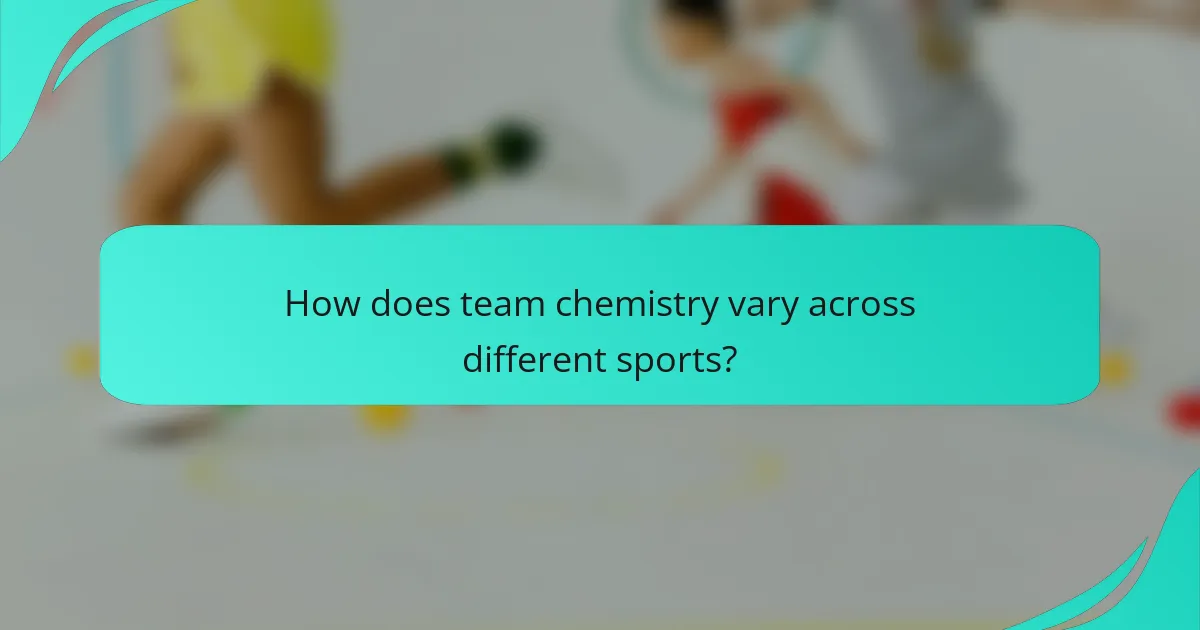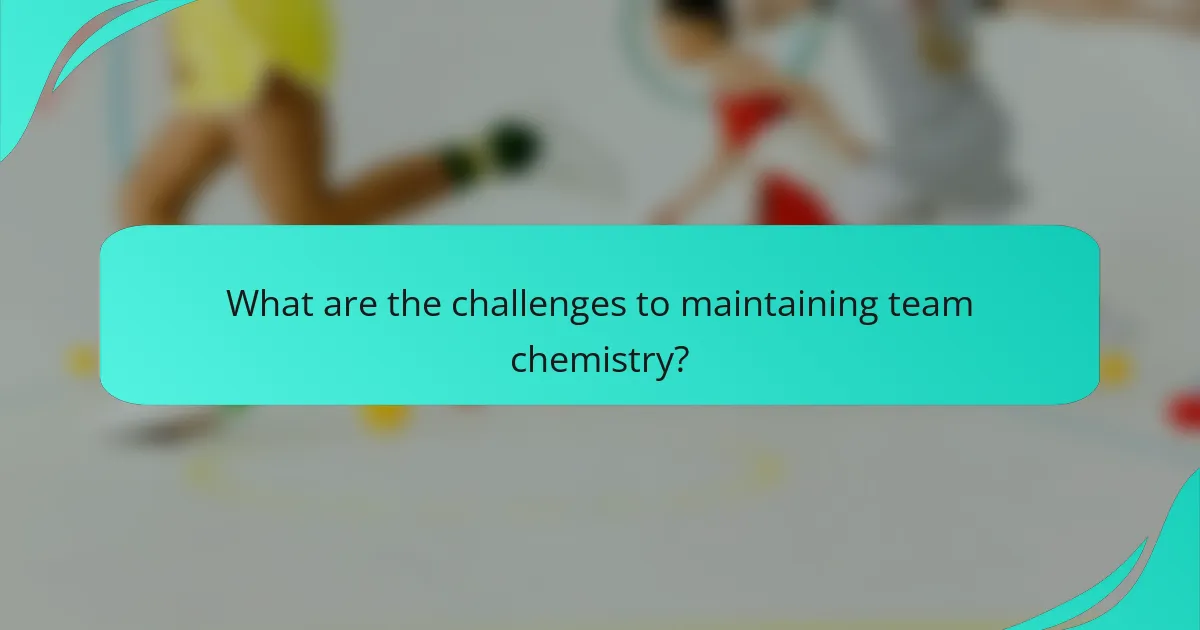Team chemistry plays a crucial role in achieving competitive success by creating a cohesive environment where members collaborate effectively. By fostering strong interpersonal relationships and aligning team goals, teams can enhance their performance, especially in high-pressure situations. Key elements such as trust and effective conflict resolution are essential for maintaining a productive dynamic.

How does team chemistry impact competitive success?
Team chemistry significantly influences competitive success by fostering a cohesive environment where members work effectively together. Strong interpersonal relationships enhance collaboration, leading to improved outcomes in high-pressure situations.
Enhances collaboration and communication
Effective team chemistry promotes open lines of communication, allowing team members to share ideas and feedback freely. When individuals feel comfortable expressing their thoughts, it leads to better problem-solving and innovation.
To enhance collaboration, teams should establish regular check-ins and create a culture of trust. Utilizing tools like shared digital platforms can facilitate ongoing dialogue and ensure everyone is aligned on goals and responsibilities.
Boosts morale and motivation
Good team chemistry contributes to higher morale, which is crucial for maintaining motivation during challenging times. When team members support each other, it creates a positive atmosphere that encourages persistence and resilience.
To foster motivation, leaders should recognize individual and team achievements regularly. Celebrating milestones, no matter how small, can reinforce a sense of belonging and drive within the group.
Improves performance and results
Teams with strong chemistry often see improved performance metrics, as members are more likely to collaborate effectively and support one another. This synergy can lead to higher productivity and better decision-making under pressure.
To measure the impact of team chemistry on results, organizations can track performance indicators such as project completion rates and overall team satisfaction. Regularly assessing these metrics can help identify areas for improvement and reinforce successful practices.

What are the key components of team chemistry?
Team chemistry consists of the interpersonal dynamics that enhance collaboration and performance among team members. Key components include trust, shared goals, and effective conflict resolution, all of which contribute to a cohesive and productive environment.
Trust among team members
Trust is the foundation of effective team chemistry, allowing members to rely on one another and share ideas openly. When team members trust each other, they are more likely to communicate honestly and take risks, which can lead to innovative solutions.
Building trust can be achieved through consistent communication, transparency in decision-making, and demonstrating reliability. Regular team-building activities can also foster trust by allowing members to connect on a personal level.
Shared goals and values
Having shared goals and values aligns team members towards a common purpose, enhancing motivation and commitment. When everyone understands and buys into the team’s objectives, it creates a sense of unity and direction.
To establish shared goals, involve all team members in the goal-setting process and ensure that the objectives are clear and measurable. Regularly revisiting these goals can help maintain focus and adjust strategies as needed.
Effective conflict resolution
Effective conflict resolution is crucial for maintaining team chemistry, as disagreements can arise even in the best teams. Addressing conflicts promptly and constructively prevents escalation and fosters a healthier team dynamic.
Encourage open dialogue and create a safe space for team members to express their concerns. Implementing structured conflict resolution strategies, such as mediation or collaborative problem-solving, can help teams navigate disputes while preserving relationships.

How can teams improve their chemistry?
Teams can enhance their chemistry by fostering strong interpersonal relationships and creating a collaborative environment. This involves intentional efforts in team-building, communication, and recognition practices that align team members toward common goals.
Regular team-building activities
Engaging in regular team-building activities helps strengthen relationships and build trust among team members. These activities can range from informal gatherings to structured workshops, and they should be designed to promote collaboration and problem-solving.
Consider scheduling monthly team outings or quarterly retreats that focus on both fun and skill development. Activities like escape rooms, team sports, or volunteer projects can provide opportunities for members to bond outside of their usual work environment.
Open communication channels
Establishing open communication channels is essential for improving team chemistry. This means creating an environment where team members feel comfortable sharing ideas, concerns, and feedback without fear of judgment.
Utilize tools like instant messaging apps or regular check-in meetings to facilitate ongoing dialogue. Encourage transparency by setting up anonymous feedback systems, which can help surface issues that may not be addressed in open discussions.
Feedback and recognition practices
Implementing effective feedback and recognition practices can significantly enhance team chemistry. Regular, constructive feedback helps team members understand their strengths and areas for improvement, fostering personal growth and team cohesion.
Recognize individual and team achievements publicly to boost morale and motivation. Simple gestures like shout-outs during meetings or a dedicated recognition board can make a big difference in how valued team members feel. Aim for a balance between formal evaluations and informal acknowledgments to maintain a positive atmosphere.

What role does leadership play in team chemistry?
Leadership is crucial for fostering team chemistry as it sets the foundation for collaboration, inclusivity, and effective communication. A strong leader cultivates an environment where team members feel valued and motivated to work together towards common goals.
Sets the tone for collaboration
Leaders establish the collaborative atmosphere by promoting shared objectives and encouraging teamwork. They should actively participate in group activities and demonstrate a commitment to collective success, which inspires team members to engage and contribute.
To enhance collaboration, leaders can implement regular team-building exercises and collaborative projects. This not only strengthens relationships but also helps in understanding each member’s strengths and weaknesses, leading to more effective teamwork.
Encourages inclusivity and respect
A leader’s approach to inclusivity directly impacts team chemistry. By recognizing and valuing diverse perspectives, leaders create a respectful environment where every team member feels heard and appreciated. This inclusivity fosters a sense of belonging and boosts morale.
Leaders should actively seek input from all team members and ensure that everyone’s contributions are acknowledged. Regular feedback sessions can help reinforce respect and inclusivity, allowing team dynamics to flourish.
Models effective communication
Effective communication is a hallmark of strong leadership and is essential for good team chemistry. Leaders must model clear, open communication by sharing information transparently and encouraging dialogue among team members.
To promote effective communication, leaders can establish regular check-ins and utilize collaborative tools that facilitate information sharing. They should also encourage team members to express their thoughts and concerns, creating a culture where communication is valued and practiced regularly.

How does team chemistry vary across different sports?
Team chemistry is crucial in all sports but manifests differently depending on the dynamics and structure of each game. In basketball, for instance, quick decision-making and seamless communication are vital, while soccer emphasizes collective strategy and positioning. Football often relies on defined roles and trust in teammates during complex plays.
Team dynamics in basketball
In basketball, team chemistry is characterized by the ability to read each other’s movements and intentions on the court. Players must develop a strong rapport to execute plays effectively, as the game often requires split-second decisions. Successful teams typically have a mix of skilled players who understand their roles and can adapt to changing situations.
To enhance team chemistry in basketball, coaches should encourage open communication and regular team-building activities. This can include drills that promote teamwork, such as passing exercises or scrimmages that focus on collaborative strategies. Avoiding isolation plays can also help foster a more cohesive unit.
Team dynamics in soccer
Soccer relies heavily on teamwork and strategic positioning, making team chemistry essential for success. Players must work together to create scoring opportunities while maintaining defensive integrity. A well-coordinated team can anticipate each other’s movements, leading to more effective plays and better overall performance.
To build chemistry in soccer, teams should focus on developing a shared understanding of tactics and formations. Regular practice sessions that emphasize teamwork, such as small-sided games, can help players learn to communicate and trust one another. Coaches should also promote a culture of support and encouragement to strengthen bonds among players.
Team dynamics in football
In football, team chemistry is vital for executing complex plays and maintaining defensive cohesion. Each player has a specific role, and trust in teammates is crucial for success. The ability to work together under pressure can significantly impact game outcomes, especially in high-stakes situations.
To enhance team chemistry in football, teams should engage in regular practice that focuses on both individual skills and collective strategies. Film sessions can also be beneficial, allowing players to analyze their performance and understand each other’s strengths and weaknesses. Establishing clear communication channels on and off the field can further solidify team dynamics.

What are the challenges to maintaining team chemistry?
Maintaining team chemistry is often hindered by various challenges that can disrupt collaboration and trust among team members. Key issues include personality clashes, high turnover rates, and external pressures that can create stress within the group.
Personality clashes
Personality clashes occur when team members have conflicting traits or working styles, leading to misunderstandings and tension. For instance, a highly detail-oriented individual may struggle to work effectively with someone who prefers a more flexible approach. Recognizing these differences early can help teams implement strategies to bridge gaps.
To manage personality conflicts, teams can establish clear communication norms and encourage open dialogue. Regular team-building activities can also foster understanding and respect for diverse perspectives, ultimately enhancing collaboration.
High turnover rates
High turnover rates can significantly disrupt team chemistry, as new members may take time to acclimate and build relationships. Frequent changes in personnel can lead to a lack of continuity, making it challenging for teams to maintain established dynamics. This can result in decreased morale and productivity.
To mitigate the impact of turnover, organizations should focus on effective onboarding processes and mentorship programs. Encouraging a supportive environment can help new members integrate more smoothly, preserving team cohesion despite personnel changes.
External pressures and stress
External pressures such as tight deadlines, high-stakes projects, or organizational changes can create stress that negatively affects team chemistry. When team members feel overwhelmed, communication may break down, and collaboration can suffer. Recognizing the signs of stress is crucial for addressing these challenges.
Teams can combat external pressures by prioritizing workload management and promoting a healthy work-life balance. Implementing regular check-ins and providing resources for stress management can help maintain a positive team environment, even under pressure.
